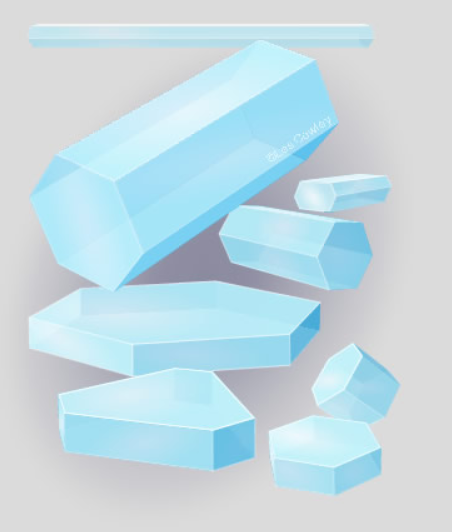Clouds Crystals - Columns & Plates
Clouds Crystals - Columns & Plates: A Detailed Exploration
Clouds are not only fascinating to look at but also hold secrets within their formations. One such intriguing phenomenon is the presence of column and plate crystals. These crystals, which are larger than the ones responsible for producing halos, add to the mystique of atmospheric optics.
Understanding Crystal Structure
Ice, with its hexagonal molecular symmetry, forms the basis for these crystals. The crystals themselves are primarily hexagonal prisms that can vary in shape, ranging from long columns to thin plates. The size of these crystals can range from 100 to 1500 times larger than those found in the clouds.
The Importance of Crystal Angles
While plates and columns may have different proportions and irregularities in their hexagonal end faces, the angles between their faces remain constant. This constancy is crucial for the formation of halos. If these angles were not consistent, we would not witness the mesmerizing halo displays in the sky.
- Alternate prism side faces always incline at a fixed angle of 60° to one another.
- The two prism end (or basal) faces incline at a constant angle of 90° to the six side faces.
- These wedge angles contribute to the creation of specific groups of halos.
Crystal Alignment and Halo Formation
The alignment of cloud crystals plays a significant role in determining the paths through which light travels, ultimately leading to the formation of distinct families of halos. Cloud crystals tend to align themselves in specific ways due to air resistance as they slowly descend relative to air currents within the clouds.
- Plate crystals, resembling falling leaves, exhibit an almost horizontal orientation as they drift down.
- Columns, on the other hand, align themselves with their long axes nearly parallel to the horizon.
Decoding Halos through Crystal Habits
To truly comprehend the intricate nature of halos, it is essential to delve into crystal habits, wedge angles, and alignments. These factors act as the keys to unlock the mysteries of halo formation and the awe-inspiring optical phenomena they create.
Crystal Variations and Halo Diversity
Ordinary hexagonal ice, known as ice Ih, represents the stable form of ice under typical cloud conditions. However, at extremely low temperatures below -80°C, cubic ice (ice Ic) can exist and produce different types of halos. While there is some debate surrounding the observation of halos from cubic ice, it remains an area of ongoing research and exploration.
- Cubic ice exhibits distinct crystal structures compared to hexagonal ice.
- Snowflakes, with their intricate hexagonal symmetry crystals, do not typically produce halos, except in the case of sun pillars.
The Fascinating World of Atmospheric Optics
The study of atmospheric optics continues to captivate scientists and enthusiasts alike. The complexity of cloud crystals and their role in halo formation unveils a world of wonder within our skies. By understanding the unique properties and behaviors of these crystals, we gain insight into the mesmerizing displays that grace our atmosphere.
As we delve deeper into the mysteries of atmospheric optics, researchers strive to uncover new insights and expand our knowledge of the celestial phenomena that surround us. With each discovery, we come closer to unraveling the secrets held within clouds, crystals, and the breathtaking halos they produce.
(Note: This article has been automatically converted from the old site and may not appear as intended. The original article can be found here.)

Column and plate crystals
These crystals are 100 - 1500X larger (depending also on your monitor) than those in the clouds which produce halos.
Ice has a hexagonal molecular symmetry. and its crystals are mostly hexagonal prisms that vary in proportion or habit from long columns to thin plates...
Plates and columns may have different relative face sizes and their hexagonal end faces can be irregular. However, regardless their individual proportions, the angles between their faces are always the same. Without this constancy we would not have halos.
Alternate prism side faces always incline at 60° to one another. The two prism end (or basal) faces always incline 90° to the six side faces. These two wedge angles each produce their own groups of halos.
Cloud crystals are commonly aligned in particular ways. This is the result of air resistance acting on the crystals as they drift slowly downwards relative to air currents in the clouds.
Plate crystals drift down like leaves. Their large faces are almost horizontal.
Columns align themselves with their long axes nearly horizontal.
Each alignment favours certain light paths through the crystals and produces its own own family of halos.
Crystal habits, wedge angles and alignments are the keys to understanding halos.
. Ordinary hexagonal ice (ice Ih) is the only stable form under ordinary cloud conditions. Cubic ice (ice Ic) might exist at very low temperatures (<-80C) and would form different halos. There is some lack of agreement on whether any halos from cubic ice have been seen.
.. Ordinary ice also forms pyramidal crystals.
Snowflakes are large and complicated hexagonal symmetry crystals and do not form halos except for some sun pillars.
Note: this article has been automatically converted from the old site and may not appear as intended. You can find the original article here.
Reference Atmospheric Optics
If you use any of the definitions, information, or data presented on Atmospheric Optics, please copy the link or reference below to properly credit us as the reference source. Thank you!
-
<a href="https://atoptics.co.uk/blog/clouds-crystals-columns-plates/">Clouds Crystals - Columns & Plates</a>
-
"Clouds Crystals - Columns & Plates". Atmospheric Optics. Accessed on April 27, 2024. https://atoptics.co.uk/blog/clouds-crystals-columns-plates/.
-
"Clouds Crystals - Columns & Plates". Atmospheric Optics, https://atoptics.co.uk/blog/clouds-crystals-columns-plates/. Accessed 27 April, 2024
-
Clouds Crystals - Columns & Plates. Atmospheric Optics. Retrieved from https://atoptics.co.uk/blog/clouds-crystals-columns-plates/.